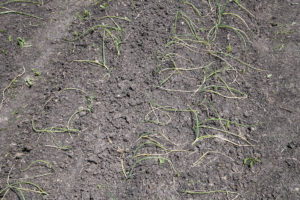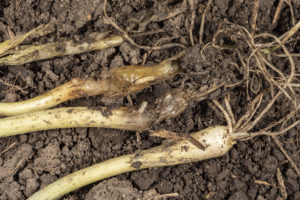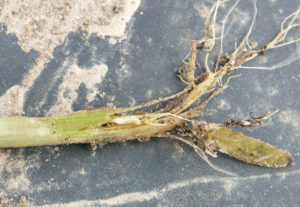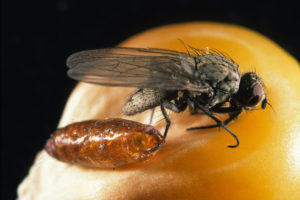Each and every spring we get reports of poor seed emergence, seedling and transplant damage in early planted crops of all sorts. Most recently in untreated sweet corn, home gardens and transplanted onions. Lucky for us, we got to dive right into this pest and see them in action, but not so lucky for the growers who weren’t expecting it! While we don’t have a lot to offer in terms of a rescue for these crops affected this year, we hope to help you plan for this in the future and understand what the threat looks like for the remainder of the season.
There are two different species to blame: the Onion Maggot (Delia antiqua) and the Seed Corn Maggot (Delia platura). There is a third species that attacks brassica crops referred to as the Cabbage Root Fly (Delia radicum). All three are nearly identical to the naked eye but can usually be determined based on the host crop association. The remainder of this article focuses on the Onion and Seed Corn Maggots.
What are onion and seed corn maggots and why do I care?
Onion maggot and seed corn maggot can wreak havoc on many vegetable crops, especially if populations have been left unchecked for multiple years. Both maggot species will feed on seedlings and either kill the plant before it can successfully mature or injure the plant, thus giving entry to soil pathogens (think bacterial rots). Damage is typically greater in cool, wet seasons and in soils with high organic matter.
Onion and seed corn maggot are very similar, and even belong to the same fly genus, Delia. These cream-colored maggots are small (0.2-0.6 inch) and have between 3-5 generations per year. Both species will overwinter as pupae in the soil and emerge as adult the following year to find suitable host plants.
How do I tell the difference between seed corn and onion maggot?
There are some slight differences in behavior and size that may indicate what species you have on your farm. Onion maggots have a strong preference for allium species, and are most problematic in onion, garlic, and leek. Seed corn maggots are highly polyphagous and can be found in as many as 40 different plant hosts. Notable cultivated hosts for seed corn maggot include soybeans, corn, beans, peas, cucumber, melon, pepper, potato, and even onion. As a general rule, seed corn maggots typically damage the seed, whereas onion maggots often feed on seedling roots.
If you find a plant infested with maggots, you may be able to distinguish species by size. Onion maggots tend to be fairly large (0.3-0.6 inch), about the size of your average housefly maggot. Seed corn maggots are smaller (0.2-0.3 inch). Determining the maggot species is difficult, and you may need to consult a local expert in order to get a positive identification.
Does it matter what species I have if I (ultimately) want them dead?
No, not really. Both species of maggot can cause significant damage to vegetable crops, and management options are very similar between the species. If you are dealing with maggot damage on your farm, consider some of the options below.
- Prevention is key. If you know you have a history of either seed corn maggot or onion maggot, make sure you take action by preventing an infestation before it starts.
- Allow sufficient time for organic matter to break down from the previous crop/cover crop/compost application in order to deter adult oviposition. They are attracted to the decomposing organic matter. Another option is to use a moldboard plow to bury the organic matter deep enough to deter oviposition.
- Rotate your crop. Onion maggot, in particular, will continue to be a problem in fields successively planted with alliums year after year. If you want to limit future infestations, consider planting a non-host crop to decrease the likelihood of subsequent maggot problems. If you are rotating your crop to a non-host, make sure you rogue out any volunteers from the previous year.
- Use a seed treatment. Insecticide treated seed can be very effective at managing either maggot species. A number of efficacious products are available including thiamethoxam+ spinosad (FARMORE), cyromazine (TRIGARD), and clothianidin and imidacloprid (SEPRESTO) for many vegetable seeds (Table 1). If you plan on using seed treatments, exercise good insecticide resistance management practices. Rotate products between years so you are not exposing multiple generations to the same active ingredient. For example, if you are using FarMore in year 1, rotate to a different seed treatment like Trigard or Sepresto in year 2.

- Exclude flies from the crop. One viable management approach is to keep female flies from finding your crop. Isolate your crop either physically or temporally to reduce maggot infestations.
- Keep it covered. Consider using row covering over your susceptible crops to stop adult oviposition (egg-laying). Multiple studies have found that this is a highly effective method at limiting damage from either seed corn or onion maggot larvae.
- Avoid maggot damage altogether by planting later in the season to bypass peak infestation. Onion and seed corn maggot have predictable phenological patterns, and you can use degree day models to accurately predict times in the season when maggot risk is high (peak emergence of adults for each generation). Are you interested in having this information available to delay planting to avoid peak adult emergence? If so, email lingwell@purdue.edu.
- Monitor, monitor, monitor. While there is little you can do to manage maggot infestations within the immediate growing season, it’s important to identify problem areas so you can plan accordingly for the following year.
- The best way to tell if you have Delia maggots on your farm is to scout early and often. Fields with poor plant emergence or wilted seedlings (Figure 1) should be inspected for maggot damage (Figures 2-4). Make sure you cull any infested plants.
- Use a trap. Multiple trapping methods for adult flies have been developed. A recent study found that white, large diameter, spherical traps paired with Delia Lure attractant were the most attractive and caught the greatest number of antiqua adults. Yellow sticky cards can also be an effective option when placed around the edges of your field. Admittedly, trapping is the second-best method for scouting seed corn or onion maggot flies. Adults are tricky to properly identify and often don’t accurately indicate the degree of infestation, but these are viable detection strategies.
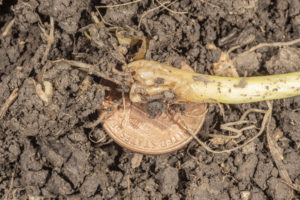
Figure 2. Maggot in young onion transplant with a penny referenced for size. Photo by John Obermeyer.
NOTE: Avoid “chasing” adult flies. You may see adult flies (Figure 5) in your field but using foliar insecticides to kill adult flies is not an effective option for either species. Keep in mind the damage is in the soil, so make sure you target your management decisions to strategies that will protect the below-ground tissues of the plant (I.e. seed treatments or in-furrow applications at planting/transplanting).
- Are there natural enemies that can help suppress the populations?
Yes, both staphylinid and ground beetles are predators that will feed on the soil-dwelling stages of these flies. Entomopathogenic nematodes (EPNs) are another option for control. They have been shown to be effective in laboratory settings, but more research is needed to identify the critical time, soil conditions and rate at which to release these enemies for adequate control in field situations.
